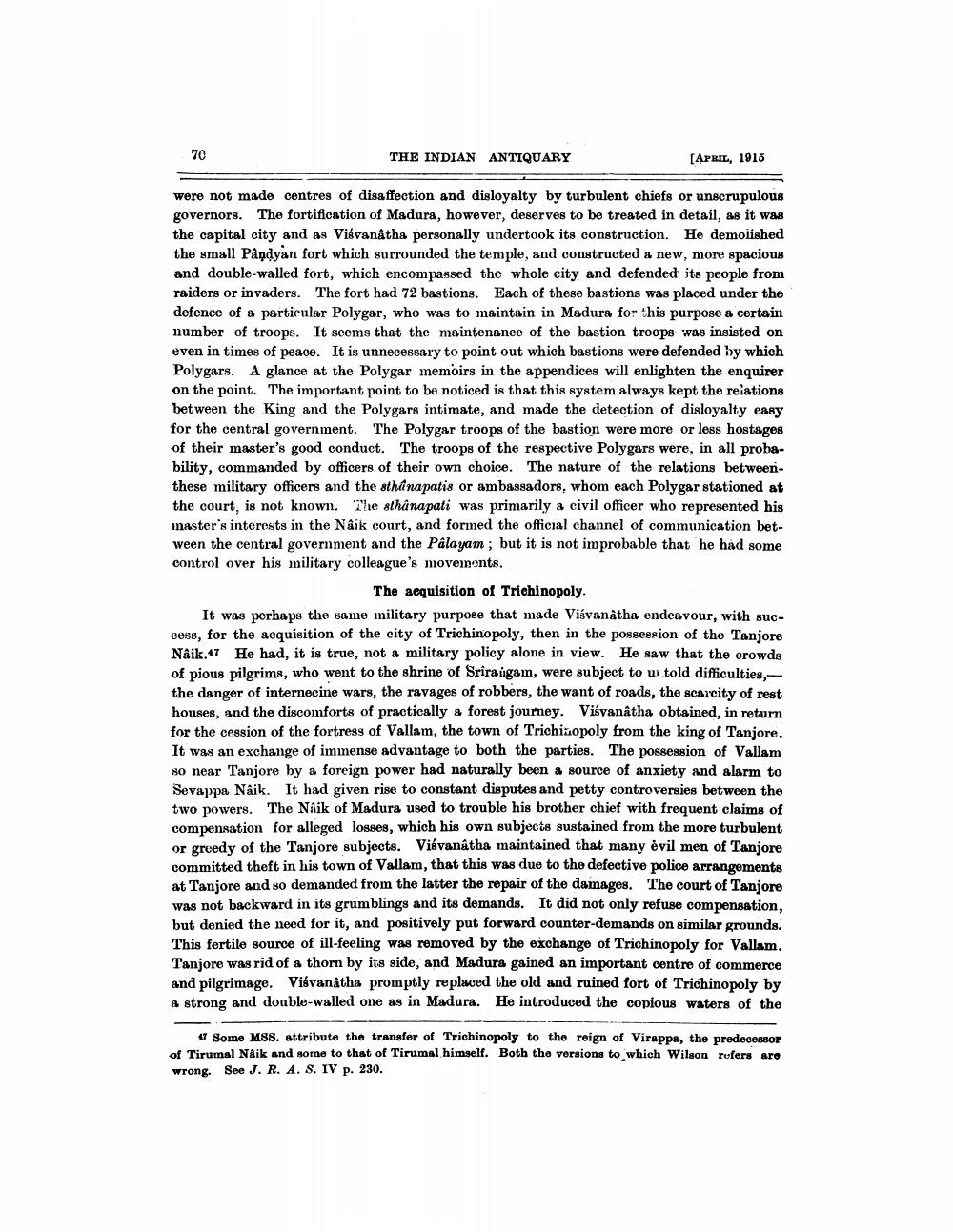________________
70
THE INDIAN ANTIQUARY
[APRIL, 1915
were not made centres of disaffection and disloyalty by turbulent chiefs or unscrupulous governors. The fortification of Madura, however, deserves to be treated in detail, as it was the capital city and as Viśvanâtha personally undertook its construction. He demolished the small Pândyan fort which surrounded the temple, and constructed a new, more spacious and double-walled fort, which encompassed the whole city and defended its people from raiders or invaders. The fort had 72 bastions. Each of these bastions was placed under the defence of a particular Polygar, who was to maintain in Madura for this purpose a certain number of troops. It seems that the maintenance of the bastion troops was insisted on even in times of peace. It is unnecessary to point out which bastions were defended by which Polygars. A glance at the Polygar memoirs in the appendices will enlighten the enquirer on the point. The important point to be noticed is that this system always kept the relations between the King and the Polygars intimate, and made the detection of disloyalty easy for the central government. The Polygar troops of the bastion were more or less hostages of their master's good conduct. The troops of the respective Polygars were, in all probability, commanded by officers of their own choice. The nature of the relations betweenthese military officers and the sthanapatis or ambassadors, whom each Polygar stationed at the court, is not known. The sthânapati was primarily a civil officer who represented his master's interests in the Nâik court, and formed the official channel of communication between the central government and the Pâlayam; but it is not improbable that he had some control over his military colleague's movements.
The acquisition of Trichinopoly.
It was perhaps the same military purpose that made Viśvanatha endeavour, with success, for the acquisition of the city of Trichinopoly, then in the possession of the Tanjore Nâik.47 He had, it is true, not a military policy alone in view. He saw that the crowds of pious pilgrims, who went to the shrine of Srirangam, were subject to w told difficulties, the danger of internecine wars, the ravages of robbers, the want of roads, the scarcity of rest houses, and the discomforts of practically a forest journey. Viśvanâtha obtained, in return for the cession of the fortress of Vallam, the town of Trichinopoly from the king of Tanjore. It was an exchange of immense advantage to both the parties. The possession of Vallam so near Tanjore by a foreign power had naturally been a source of anxiety and alarm to Sevappa Naik. It had given rise to constant disputes and petty controversies between the two powers. The Naik of Madura used to trouble his brother chief with frequent claims of compensation for alleged losses, which his own subjects sustained from the more turbulent or greedy of the Tanjore subjects. Viśvanâtha maintained that many evil men of Tanjore committed theft in his town of Vallam, that this was due to the defective police arrangements at Tanjore and so demanded from the latter the repair of the damages. The court of Tanjore was not backward in its grumblings and its demands. It did not only refuse compensation, but denied the need for it, and positively put forward counter-demands on similar grounds. This fertile source of ill-feeling was removed by the exchange of Trichinopoly for Vallam. Tanjore was rid of a thorn by its side, and Madura gained an important centre of commerce and pilgrimage. Viśvanâtha promptly replaced the old and ruined fort of Trichinopoly by a strong and double-walled one as in Madura. He introduced the copious waters of the
47 Some MSS. attribute the transfer of Trichinopoly to the reign of Virappa, the predecessor of Tirumal Naik and some to that of Tirumal himself. Both the versions to which Wilson refers are wrong. See J. R. A. S. IV p. 230.




